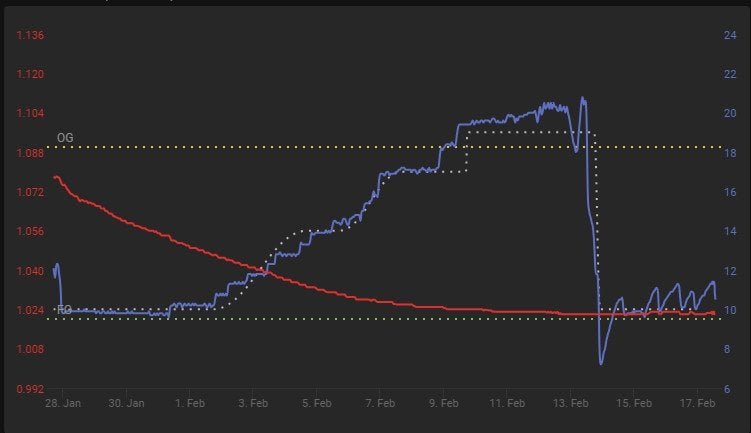Doppelbock
What is Doppelbock? According to the BJCP guidelines (2021), it is “a strong, rich, and very malty German lager that can have both pale and dark variants. The darker versions have more richly-developed, deeper malt flavors, while the paler versions have slightly more hops and dryness.”
| BJCP Category | 9A |
| ABV | 7.0–10.0% |
| Original Gravity (OG) | 1.072–1.112 |
| Final Gravity (FG) | 1.016–1.024 |
| IBU | 16–26 |
| Color (EBC/SRM) | 6–25 SRM |
One Way to Brew A Doppelbock
This recipe was inspired by Mr. Maltinator from Brewing Classic Styles. This doppelbock is heavy on Munich malt (70% of the grist) and should be a nice copper color.
Batch Vital Statistics
| Stat | Value |
|---|---|
| Batch Volume | 15 L |
| OG | 1.090 |
| FG | 1.022 |
| ABV | 8.9 % |
| Color | 34 EBC |
| IBU | 23 |
| Boil Time | 60 minutes |
Recipe
Water Profile
| Ca2+ (ppm) | Mg2+ (ppm) | Na+ (ppm) | Cl– (ppm) | SO42- (ppm) | HCO3– (ppm) | pH |
|---|---|---|---|---|---|---|
| 39 | 8 | 37 | 28 | 78 | 81 | 5.44 |
To reach the target water profile, I added half of a Campden tablet and 1.5 mL lactic acid to my source water.
After heating the water to 68 °C, a portion was removed to reserve as sparge water.
Fermentables
| % | kg | lb | Grain/Adjunct |
|---|---|---|---|
| 70 | 6.4 | 14 | BestMalz Munich |
| 20 | 1.8 | 4 | BestMalz Pilsen |
| 10 | 0.9 | 2 | Weyermann Caramunich II |
Mash Profile
Milled grains were slowly added to the strike water while thoroughly stirring the grain into the water to ensure all of the grain was wet.
After 20 minutes into the mash, I took an aliquot and cooled the sample to 18 °C. The pH measured 5.44.
| Step | Temperature (°C) | Temperature (°F) | Time (minutes) |
|---|---|---|---|
| Saccharification Rest | 68 | 154 | 60 |
| Mash-out | 75 | 167 | 10 |
After mashing out, the grains were sparged, or rinsed, with water.
The wort was then heated to a boil.
Hops
| Hop | % Alpha Acid | Time | IBU |
|---|---|---|---|
| Hallertau Magnum | 12.5 | 30 | 21 |
| Hallertau Mittlefrüh | 2.7 | 15 | 3 |
Yeast
For this recipe, I used L28 Urkel from Imperial Yeast. Instead of a yeast starter, I brewed a Munich Helles and used the yeast cake leftover from that fermentation.
The wort was chilled to 10 °C and transferred to a Kegland Fermzilla All Rounder 30L fermenter.
For this batch, I also performed a Forced Fermentation Test to predetermine the target final gravity. The result: 1.020, making this have the potential to be a 9.2% beer!
Fermentation Profile
I used a modified Narziss fermentation profile for this batch, using my quick lager calculator to come up with the table below:
| Step | Temperature (°C) | Temperature (°F) | Time | Gravity for Narziss Fermentation Profile |
|---|---|---|---|---|
| Primary | 10 | 52 | 7 days | 1.090 |
| Ramp | 10 to 14 (1 °C/day) | 50 to 57 (1.7 °F/day) | 4 days | |
| 14 | 57 | 1 days | 1.056 | |
| Ramp | 14 to 18 (1 °C/day) | 57 to 64 (1.7 °F/day) | 4 days | 1.038 |
| Diacetyl Rest | 18 | 64 | 3 days | 1.027 |

Conditioning and Carbonation
After fermentation, the beer was transferred to a keg, fined with Silafine from Cellar Science, and carbonated to 2.5 volumes of CO2. The beer finished at 1.022, making this 8.9% ABV.
| Step | ||
|---|---|---|
| Conditioning | 5 °C/41 °F | 14 days |
| Carbonation | 12 psi | 2.5 volumes of CO2 |
Recipe Impressions
This doppelbock is a clear, copper beer with an off-white head.

It has a toasted malt aroma with a moderate alcoholic note on the nose. It has a medium-full body with moderate carbonation. There’s a light alcohol warms, but it goes down smooth. The flavor is very rich and malty sweet, with some dark fruit notes like plums.
This is a big beer that is much like bread in a glass. Very filling. No wonder the monks brewed this for their Lenten fasts.
Do you enjoy Doppelbocks? Let me know what you like or dislike about this style in the comments below!
